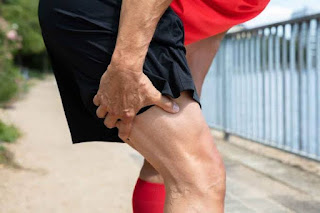Precautions to minimize muscles/hamstring injures for active sportsmen
Minimizing hamstring injuries for active sportsmen involves a combination of proper training, warm-up routines, strengthening exercises, and adopting good recovery practices. Here are some strategies to consider:
1. **Proper Warm-Up and Cool-Down**: Always start your training sessions with a dynamic warm-up to increase blood flow and prepare your muscles for activity. After your workout, include static stretches to maintain flexibility.
2. **Gradual Progression**: Avoid sudden increases in training intensity or volume. Gradually progress to more intense activities to allow your muscles to adapt and avoid overloading the hamstrings.
3. **Strength Training**: Incorporate hamstring-specific exercises like deadlifts, Romanian deadlifts, leg curls, and glute bridges into your routine. Strengthening the hamstrings helps support the muscles and reduce the risk of injury.
4. **Balance and Stability Work**: Focus on exercises that improve balance and stability, as these help prevent awkward movements that can strain the hamstrings.
5. **Flexibility Training**: Regularly stretch your hamstrings to maintain flexibility and prevent muscle imbalances. Gentle, regular stretching can help reduce the risk of strains.
6. **Cross-Training**: Incorporate a variety of activities to avoid overuse injuries. Cross-training can help engage different muscle groups and reduce strain on specific areas.
7. **Proper Technique**: Use proper form and technique when performing exercises and sports movements. Poor form can lead to muscle imbalances and increased injury risk.
8. **Rest and Recovery**: Allow adequate time for recovery between intense training sessions. Sleep, nutrition, and hydration play crucial roles in muscle recovery and injury prevention.
9. **Listen to Your Body**: Pay attention to any discomfort or signs of strain. If you feel pain, it's important to address it rather than pushing through.
10. **Consult Professionals**: Work with a certified trainer or sports physiotherapist to create a well-rounded training program that suits your needs and goals.
11. **Dynamic Stretching**: Incorporate dynamic stretches that mimic the movements of your sport. This can improve flexibility and prepare the hamstrings for the demands of your activity.
12. **Foam Rolling**: Use foam rolling to release tension and improve blood flow in your muscles. Focus on the hamstrings and surrounding areas.
Remember that preventing injuries is a holistic approach that includes proper training, nutrition, rest, and self-care. By taking these steps, you can help minimize the risk of hamstring injuries and perform at your best in your chosen sport. If you experience persistent pain or discomfort, consult a healthcare professional for proper evaluation and guidance.
While there is no specific "hamstring injury prevention diet," adopting a well-balanced and nutrient-rich diet can certainly contribute to overall muscle health and injury prevention for sportsmen. Here are dietary guidelines to consider:
1. **Protein**: Protein is essential for muscle repair and recovery. Include lean sources of protein such as lean meats, poultry, fish, eggs, dairy products, legumes, and plant-based protein sources.
2. **Carbohydrates**: Carbohydrates provide energy for workouts and support muscle glycogen replenishment. Opt for complex carbs like whole grains, fruits, vegetables, and legumes.
3. **Healthy Fats**: Omega-3 fatty acids found in fatty fish, flaxseeds, chia seeds, and walnuts can help reduce inflammation and support joint health.
4. **Hydration**: Staying properly hydrated is crucial for muscle function and preventing cramps. Drink water consistently throughout the day and pay extra attention to hydration during training sessions.
5. **Vitamins and Minerals**: Nutrients like vitamin D, calcium, magnesium, and potassium play roles in muscle function and bone health. Include a variety of fruits, vegetables, nuts, and dairy products to ensure you're getting a range of vitamins and minerals.
6. **Anti-Inflammatory Foods**: Foods with anti-inflammatory properties can help reduce the risk of muscle strains. Incorporate foods like berries, turmeric, ginger, green tea, and olive oil into your diet.
7. **Collagen-Rich Foods**: Collagen is important for connective tissue health, including tendons and ligaments. Collagen-rich foods include bone broth, fish, and collagen supplements.
8. **Pre-Workout Nutrition**: Consume a balanced meal or snack containing carbs and protein about 1-2 hours before workouts to provide energy and support muscle function.
9. **Post-Workout Nutrition**: After training, consume a meal or snack with protein and carbs within the first hour to aid muscle recovery and glycogen replenishment.
10. **Avoid Excessive Restriction**: Avoid extremely low-calorie diets, as they may not provide enough energy to support your training demands.
11. **Individual Needs**: Every athlete is unique, so consider consulting a registered dietitian or sports nutritionist to tailor your diet to your specific needs and goals.
12. **Supplements**: While it's best to get nutrients from whole foods, some athletes may benefit from supplements like omega-3 fatty acids, vitamin D, and collagen. Consult a healthcare professional before adding supplements to your routine.
Remember that overall diet quality and consistency are key. A well-rounded, nutrient-dense diet that meets your energy and nutrient needs can help support muscle health and minimize the risk of injuries, including hamstring strains.



.jpeg)
Comments
Post a Comment